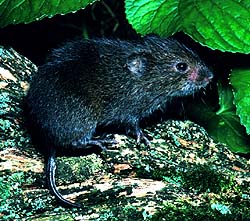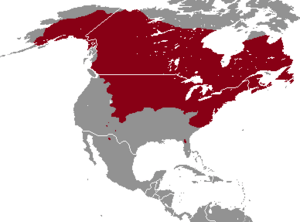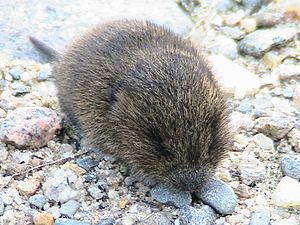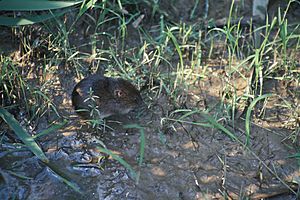Meadow vole facts for kids
Quick facts for kids Meadow vole |
|
|---|---|
 |
|
| Conservation status | |
| Scientific classification | |
| Genus: |
Microtus
|
| Species: |
pennsylvanicus
|
 |
|
The meadow vole (Microtus pennsylvanicus) is a small rodent, sometimes called a field mouse or meadow mouse. It lives across North America, including Canada, Alaska, and the northern United States. Its home also stretches south along the Atlantic coast. One special type, the Florida salt marsh vole (M. p. dukecampbelli), lives in Florida. It is considered an endangered animal. Meadow voles used to live in Chihuahua, Mexico, but haven't been seen there since 1998.
Meadow voles are active all year long, often at night. They dig tunnels underground where they store food for winter. Female voles also give birth to their babies in these burrows. Even though these animals often live close to each other, they can be quite aggressive. This is especially true for males during the breeding season. Meadow voles can sometimes harm fruit trees, garden plants, and farm crops.
Contents
Where Meadow Voles Live
The meadow vole lives in more places than any other Microtus species in North America. They are found from Labrador in the east all the way to Alaska in the west. Their range goes south from Labrador and New Brunswick to South Carolina and parts of Georgia. It also extends west through states like Tennessee, Missouri, and Wyoming, reaching central Washington and Alaska. They are not found in the coldest, most northern polar regions. There's also a separate group living in central Colorado and northwestern New Mexico. The Souris River in the United States is sometimes called the Mouse River. This is because so many field mice, like the meadow vole, used to live along its banks.
Meadow Vole Homes: Plant Communities
Meadow voles usually live in grassy areas. They prefer places that are a bit wet. However, they can also be found in wooded areas. In parts of Washington and Idaho, many meadow voles live in wet, grassy areas called sedge fens. But they are not found in nearby cedar, hemlock, or pine forests. Moisture seems to be very important for where they choose to live. Sometimes, having free water nearby is the main reason they pick a spot.
In Minnesota, meadow voles live in areas with shrubs near rivers, and in tallgrass prairies. In Ohio, they were found in wetlands with common cattails. In Virginia, they were most common in fields with thick grass. They were less common in areas with eastern red cedar trees. Meadow voles generally like habitats with lots of dense plants. They are often found where there is thick grass and plant litter on the ground.
Daily Habits
Meadow voles are active all year, day and night. Their activity changes based on the season, their habitat, how much cover they have, and the temperature. Meadow voles need to eat often. They are active for two to three hours at a time, which helps them digest their food. In Canada, they are most active a few hours after sunrise and for two to four hours before sunset. They spend most of their inactive time resting in their nests.
Life Cycle and Reproduction
A female meadow vole carries her babies for about 20 to 23 days. When they are born, the babies are pink and have no fur. Their eyes and ears are closed. Fur starts to grow by three days old. By seven days, they have fur everywhere except their belly. Their eyes and ears open around eight days old. The young voles stop drinking their mother's milk when they are 12 to 14 days old. Babies born in spring and early summer reach their adult weight in about 12 weeks. However, they lose some weight in the fall. Babies born in late summer keep growing through the fall and stay at that weight through winter. They reach their biggest size between two and 10 months old.
A typical litter of meadow voles has four to six babies. Sometimes there can be as few as one or as many as eleven. On average, about 2.6 babies from each litter survive. The size of the litter doesn't seem to depend on where they live or how many other voles are around. Litters born in fall, winter, and spring are usually smaller than summer litters. Female meadow voles can start having babies earlier than males. Some females can get pregnant as young as three weeks old. Males are usually six to eight weeks old before they can produce mature sperm. One female in captivity had 17 litters in one year, with a total of 83 babies! One of her babies had 13 litters (78 babies) before she was even a year old.
Most meadow voles don't live very long. The average lifespan is less than one month because many young voles die. Adult voles usually live for about two more months once they are grown. The highest death rate is for young voles after they leave the nest. The longest a meadow vole has lived in the wild is 16 months. Very few voles live longer than two years.
Meadow vole populations change each year. They often reach their highest numbers every two to five years. Then their numbers drop in the years in between. Breeding usually stops in January and starts again in March. Over a year, there are usually fewer meadow voles in early spring. Their numbers then grow quickly through summer and fall.
In years with average numbers, you might find about 15 to 45 meadow voles per acre in old fields. In peak years, their numbers can reach 150 per acre in marshy areas, which they like even more. Sometimes, in northern wetlands, there can be over 1,482 meadow voles per hectare (about 600 per acre). When there is a lot of dense plant cover, meadow vole populations can grow very large.
Meadow Vole Habitat
The best home for a meadow vole is a moist, thick grassland with lots of dead plants on the ground. They choose their homes based on how much grass and other plants are there. Things like soil temperature, moisture, and how many other animals are around also play a role. Meadow voles are most often found in places with wet soil. They often stick to the wettest spots when they live near other types of voles.
Meadow voles clearly prefer habitats with thick plants. In tallgrass prairies, they are found where the plants are very dense. In Virginia, important things for meadow vole homes include plant cover that is 8 to 16 inches (20–41 cm) tall and lots of plant litter. They seem to be spread out randomly in grasslands in southern Quebec. It's hard to tell if they choose dense plants for food or for cover.
In Massachusetts, more meadow voles were found where there were fewer woody stems and shrubs. They were most common in areas with more grasses and other soft plants, and less woody cover. If there wasn't enough grassy cover, they preferred woody areas over very sparse plants.
Meadow voles are found in open areas with a thick mat of perennial grass. In Illinois, they were the most common small mammals in fields with Indian grass and switchgrass. They were not common in fields with orchard grass. The most stable populations were in areas with big bluestem grass that had not been burned.
Meadow voles tend to stay in their home areas. They will defend parts of their home from other voles. Their home areas can overlap and have irregular shapes. The size of their home depends on the season, the habitat, and how many other voles are around. Their homes are larger in summer than in winter. They are also larger in marshes than in meadows. When there are many voles, their home areas become smaller. Home ranges can be from 0.08 to 2.3 hectares (0.32-0.9 acres). Female voles have smaller home ranges than males. However, females are more protective of their space. Often, babies from one litter are still in the mother's home range when the next litter is born.
Cover Needs
Meadow voles use nests for their babies, for resting, and for protection from the weather. They build their nests from woven grass. Nests are usually underground or hidden under boards, rocks, logs, brush piles, hay bales, fenceposts, or in clumps of grass. Meadow voles dig shallow tunnels. Inside these tunnels, they build their nests in larger chambers. In winter, nests are often built on the ground surface under a layer of snow, usually next to a rock or log.
Meadow voles also create runways or paths through dense grasses.
What Meadow Voles Eat
Meadow voles eat most types of grasses, sedges, and other plants they can find. This includes many plants grown on farms. In summer and fall, they cut grasses into small pieces to get to the juicy parts of the leaves and seeds. Leaves, flowers, and fruits of other plants are also common in their summer diet. They sometimes eat fungi. Occasionally, they eat insects and snails. They might also eat dead animals. When there are many voles, they sometimes eat each other. Meadow voles can damage woody plants by eating the bark all the way around the stem, which can kill the plant. This happens when their population is very high.
In winter, meadow voles eat the green parts of grass plants, often hidden under the snow. They also eat seeds, roots, and bulbs. Sometimes, they strip the bark from woody plants. They store seeds and tubers in their nests and burrows.
In Quebec, meadow voles liked to eat plants like quackgrass, sedges, fescues, wild strawberry, timothy, bluegrasses, and bird vetch.
Who Eats Meadow Voles: Predators
Meadow voles are a very important food source for many animals. This includes hawks, owls, and many meat-eating mammals. Some snakes also eat them. Almost all types of birds of prey eat small rodents like voles. Even birds not usually thought of as mouse predators will eat voles. These include gulls, northern shrikes, black-billed magpies, common ravens, American crows, great blue herons, and American bitterns. In Ohio, meadow voles made up 90% of the food eaten by long-eared owls. In Wisconsin, they were 95% of the food for short-eared owls.
Most mammal predators eat voles. The American short-tailed shrew is a major predator. Meadow voles try to avoid areas where these shrews are common. Other important mammal predators include badgers, striped skunks, weasels, martens, domestic dogs, domestic cats, and mountain lions. Other animals that have been reported to eat voles include trout, Pacific giant salamanders, garter snakes, yellow-bellied racers, gopher snakes, rattlesnakes, and rubber boas.
In northern wetlands, meadow voles are a big part of the diet for red foxes, minks, short-eared owls, and northern harriers. Snakes like racers often eat voles. Racers and voles sometimes even share the same burrows.
Managing Meadow Vole Populations
Meadow voles are common in farm areas. They can damage many crops. This includes root vegetables (like asparagus), leafy vegetables, fruits that grow low to the ground (like beans), the bark of fruit trees, and grains. Meadow voles are also considered pests in tree plantations. In British Columbia, a large number of meadow voles seemed to cause problems for new tree seedlings.
To manage meadow vole numbers in farm areas, people can reduce their habitat. This means mowing or plowing grassy areas along roadsides and fencerows. Protecting predators, especially birds of prey, is also important to help keep vole numbers in check. Direct ways to control them include trapping, fencing, and using poisons. Trapping and fencing are not always very effective for large areas. Poisons can be effective. Repellents usually don't work well right now. Plastic mesh tubes can protect seedlings from voles and other rodents. Cultivating the land at the right time and using controlled fires can also help reduce their numbers.
The changing numbers of meadow voles are very important for their predators. Meadow voles are usually the most common small mammals in northern wetlands. Their numbers can make up over 40% of all small mammals there. The numbers of short-eared owls, northern harriers, rough-legged hawks, coyotes, and red foxes are often linked to how many meadow voles are around. More voles usually mean more predators.
Meadow voles can carry different types of parasites. These include worms (like trematodes, cestodes, nematodes, and acanthocephalans), lice, fleas, flies, and ticks and mites.
Meades voles can also carry diseases that can affect humans. These include cystic hydatid disease, tularemia, bubonic plague, babesiosis, giardiasis, and the bacteria that causes Lyme disease (Borrelia burgdorferi).
Ecological Importance
Like many other small mammals, meadow voles play important roles in nature. They are a key food source for many predators. They also help spread mycorrhizal fungi, which are good for plants. Meadow voles eat a lot of grass and help spread nutrients from grass through their droppings. After big changes to an area, like forest fires, meadow voles help the habitat recover. They prefer open, non-forest areas and move into these open spaces created by fires or other clearings. Very few meadow voles are found in forests or woodlands. In these newly opened areas, the vole quickly becomes a food source for predators.
|
See also
 In Spanish: Microtus pennsylvanicus para niños
In Spanish: Microtus pennsylvanicus para niños





